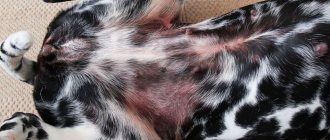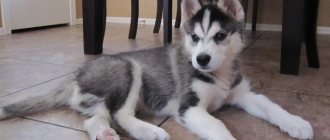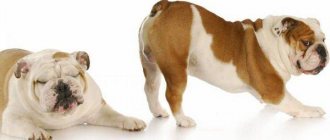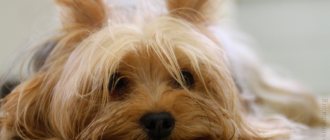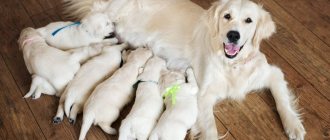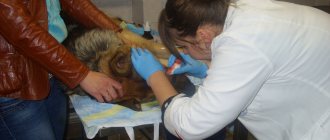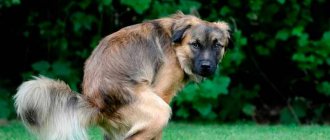Dog intestinal microflora
The natural habitat of lacto- and bifidobacteria is the intestine. The colonization of the digestive organ by beneficial microorganisms occurs in the first 3-4 days after the puppy is born. A newborn animal receives beneficial bacteria primarily from the bitch’s colostrum.
Puppies after cesarean section are more susceptible to the development of dysbiosis, since they are deprived of access to colostrum in the first hours after birth.
In healthy puppies and adults, the intestinal microflora is predominantly inhabited by bifidobacteria, lactobacilli, and E. coli. These microorganisms perform a protective function. They inhibit the growth of microbes and neutralize the effects of toxins in the intestines.
Beneficial bacteria are involved in the process of absorption and breakdown of nutrients. In addition, probiotic and eubiotic microorganisms synthesize vital B vitamins in the dog’s intestines. They protect the animal’s body from viruses, helminth infections, and fungi.
External and internal negative factors gradually lead to beneficial microflora being replaced by pathogenic microorganisms:
- staphylococci;
- Pseudomonas aeruginosa;
- fungi of the genus Candida;
- Proteus.
To restore beneficial microflora, it is imperative to take probiotics, prebiotics or synbiotics, and prescribe a special diet as part of complex therapy.
Causes of dysbiosis in dogs
When a puppy is born, its intestinal tract is essentially sterile. There is even no beneficial microflora. In the first hours after birth, the female begins to feed the offspring. She produces first-born milk or colostrum, which has a unique set of useful elements, including necessary bacteria.
As the puppy grows up, he begins to taste the objects that surround him, visits the street and tries other food that is new to him. The beneficial bacteria already present in the intestines, obtained from mother’s milk, are joined by new ones.
As a rule, the final creation of individual intestinal microflora occurs between the ages of 8 months and 1 year. The intestinal microflora of a dog is vital and has a number of important functions:
- has a pronounced effect in the general process of formation and strengthening of immune defense;
- normalizes metabolic processes, promoting the absorption of beneficial nutrients by the intestinal walls, while removing excess moisture;
- organizes the protection of the dog’s body from the action of pathogenic bacterial microflora that penetrates the intestines;
- promotes the process of synthesis of vitamin substances;
- has a pronounced effect on the process of absorption and elimination of toxic substances from the body.
When processes in the functioning of beneficial microflora are disrupted, dysbacteriosis occurs. The number of harmful bacteria increases, their activity increases, and the beneficial microflora rapidly dies, without the opportunity to fully recover. Dysbiosis develops, characterized by a sharp decrease in lacto and bifidobacteria (permanent residents of the intestinal tract). Their place is taken by fungal microorganisms, E. coli, staphylococci and other opportunistic bacteria.
Intestinal dysbiosis in a dog is a rather dangerous pathological process that affects the proper functioning of the entire body. In the absence of timely treatment, dysbiosis can provoke a number of disorders.
Dysbiosis, or disruption of the correct balance of beneficial and pathogenic microflora in the intestines of an animal, can occur as a result of exposure to certain factors. The main ones are:
- problems in organizing feeding and violation of the diet (large amounts of carbohydrate substances in the dog’s diet);
- stressful conditions, emotional stress due to moving, changing ownership, or the appearance of another animal in the house;
- unfavorable environmental conditions in the region of residence;
- lack of training, as a result of which the animal picks up various objects on the street and also often goes to garbage bins;
- taking medications - frequent and uncontrolled use of medications (often antibiotics), leads to serious disruptions in the functioning of the entire body, in particular affecting the intestinal microflora;
- chronic diseases in the digestive system (gastritis, duodenitis, colitis and enterocolitis);
- increased sensitivity of beneficial intestinal microflora even to minor changes;
- Severe helminthiases (ascariasis, cucumber tapeworm) lead to damage to the intestinal walls and general disturbances in the functioning of the body.
It is important to note that dysbiosis in the vast majority of clinical cases is diagnosed in small puppies transitioning from mother's milk to adult food and in dogs over 7 years old due to age-related changes in the body.
Causes
Dysbacteriosis in a dog, the symptoms and treatment of which require mandatory attention from the pet owner, often develops against the background of the following negative factors:
- completing a course of antibiotic therapy;
- inflammatory diseases of the gastrointestinal tract;
- change in food composition;
- poisoning;
- helminthic infestation;
- infectious diseases.
Dysbiosis can develop in a puppy when it refuses mother's milk and suddenly switches to low-quality industrial food. Also, bacterial overgrowth syndrome in young animals often occurs due to infection with worms.
If a nursing bitch has a staphylococcal infection, cocci can be transmitted to puppies. Pathogenic microorganisms quickly attack the digestive system of newborn puppies, leading to the development of diarrhea and dehydration.
Treatment of the disease
The therapeutic regimen depends entirely on the stage of the disease. If the disease was detected promptly, the doctor will adjust the dog’s diet and also prescribe the addition of various nutrients to its food. In advanced forms, treatment of dysbiosis in dogs requires complex measures. These include:
- Elimination of excessive contamination of intestinal microflora. Antibacterial drugs, bacteriophages and lactic acid will help normalize its condition.
- Removal of toxic substances accumulated during the course of the disease. Sorbents and infusion solutions can effectively cope with this.
- Probiotic agents will help restore microflora.
- Actions aimed at improving metabolism. The most important thing in this is to create the right menu, rich in vitamins and microelements.
- Drugs such as immunomodulators will enhance your pet’s protection from the harmful effects of bacteria and poor environmental conditions.
If the owner is wondering how to treat an advanced form of dysbiosis, then the best option for this is taking antibiotics. Their choice and dosage is prescribed only by a specialist, since such drugs themselves negatively affect the microflora. The most popular antibiotics are Furadonin, Levomycetin, Ampiox-sodium. The effectiveness of therapy is increased by saline solutions, which are administered subcutaneously as injections.
Bacterial preparations, such as Lactoferon and Fitobacterin, containing yeast and lactobacilli, can quickly suppress pathogenic processes in the dog’s intestines. The treatment is enhanced if it is supplemented with the intake of drugs synthesized in the form of enzymes secreted by the stomach in its healthy state.
The owner must be prepared for the fact that treatment of dysbiosis will take a significant amount of time, on average from one to two months. During this period, you should not once again disturb the animal without doing anything, force it to eat or engage in intense physical activity. The dog should always have the opportunity to drink enough fresh water, as well as sleep soundly and well.
Symptoms
The following symptoms will help recognize dysbiosis in adult dogs:
- loose stools, sometimes followed by constipation;
- mucus impurities in feces;
- change in color of stool;
- poor appetite;
- decreased activity;
- rumbling and bloating;
- weight loss.
Puppies show the same signs of intestinal microflora disturbance as adults.
Diagnostics
Before treating dysbiosis, the dog should make an appointment with a veterinarian for an accurate diagnosis. The doctor will collect anamnesis and prescribe the necessary examination.
To identify the syndrome of excessive microbial growth in the intestines, a stool test for dysbacteriosis is prescribed. If conditionally pathogenic bacteria are detected in the test material in quantities above the permissible norm, the presence of dysbiosis in the animal should be assumed.
If gastrointestinal pathology is suspected, radiography and ultrasound of the abdominal cavity are performed. A biopsy of intestinal tissue allows you to get an accurate picture of the state of the digestive system.
Diagnosis and prevention of dysbiosis in dogs and cats
Before starting treatment for dysbiosis, it is necessary to clearly establish the cause that caused it. In our veterinary clinic, the diagnosis of dysbacteriosis and the establishment of its causes is made through the examination of stool using a unique method of phase-contrast microscopy . The analysis is done within an hour. Further, depending on the etiology (cause) of the disorder, the doctor prescribes the most effective treatment regimen.
To prevent the development of dysbiosis, it is recommended to conduct preventive stool examinations in the spring and autumn, as well as after suffering from various diseases, especially after the use of potent medications.
If for some reason it is difficult for you to bring your pet to the clinic for a preventive examination, in the absence of external symptoms of the disease, you can, first, simply bring feces for analysis. We will send you the result by email, after which, if any violations are detected, you need to take the animal and seek advice based on the results of the study.
Violations identified at an early stage can be easily corrected. Monitoring the condition of the intestines and maintaining normal microflora is the key to good health and strong immunity of your pet!
Treatment options
Intestinal dysbiosis in dogs is not an independent disease, so before treating the syndrome, you should find out the cause of its occurrence and eliminate it.
If there is a disturbance in the functioning of the intestinal tract, first of all it is necessary to exclude infestation by intestinal parasites. The animal is dewormed twice with an interval of 2 weeks using anthelmintics (Drontal, Milbemax, Kanikvantel, etc.)
If staphylococcal or any other intestinal infection is detected, a course of antibiotics (Levomycetin, Ampicillin, Amptox sodium, etc.) is mandatory. Additionally, saline solutions and droppers are prescribed. Along with antibiotics, according to the doctor's indications, the animal is given antimycotics (Nystatin), which prevent the growth of fungi of the genus Candida. To restore damaged intestinal microflora, Hilak-Forte is prescribed.
Treatment of dysbiosis in dogs includes a set of measures aimed at:
- purgation;
- improving the functioning of the digestive system;
- restoration of beneficial microflora.
To cleanse the intestines of waste and toxins, enterosorbents (Smecta, Lignitin) are prescribed.
Enzyme preparations help improve the functioning of the digestive system. Veterinarians often prescribe Mezim and Cholenzym for this purpose.
If there is diarrhea, the dog is given decoctions of rice, chamomile or oak bark.
To restore the population of beneficial bacteria, long-term treatment with probiotics is carried out.
Symptoms and consequences of dysbiosis
With the intensive development of opportunistic (causing diseases under certain conditions) microflora, putrefactive processes develop, as well as the accumulation of many toxic substances, which are subsequently absorbed in large quantities into the blood, entering the portal vein and then the liver.
There is a direct connection between the development of dysbiosis in dogs and cats and the appearance of cirrhosis, chronic hepatitis, decreased immunity, chronic colitis, gastritis, the development of intolerance syndrome to certain foods, dermatitis, etc.
A lack of bifidobacteria leads to a decrease in the amount or absence of substances such as mannose and fructose, which in turn leads to impaired carbohydrate metabolism and a decrease in the synthesis of new intestinal cells. As a result, old cells continue to function without being replaced by new ones. This leads to constipation, self-poisoning of the body and overload of the kidneys. Since the kidneys are not able to remove compounds that are poorly soluble in water, stones and sand form in them.
Signs of metabolic disorders include: – weight loss – lack of bile acid secretion – deficiency of fat-soluble vitamins – decreased calcium absorption Clinically, this can be manifested by deterioration of the structure of the coat and skin, decreased vision, and the development of osteoporosis.
Among other things, when the normal composition of the intestinal microflora is disrupted, the rapid development of pathogenic microbes, fungi and protozoa occurs, many of which are able to penetrate the intestinal walls and spread throughout the body with the blood. This leads to numerous disturbances in the functioning and structure of various organs and tissues, the appearance of ulcers, erosions, dermatitis, allergization of the body and other associated diseases.
Often, local treatment of this type of disease does not provide a lasting effect precisely because the cause of the disorder is incorrectly identified. At the same time, normalization of intestinal microflora automatically entails general improvement of the body and the disappearance of many symptoms.
Probiotic therapy
Dysbiosis in puppies and adults can be treated with human and veterinary probiotics. Among the most effective veterinary medications, doctors identify:
- Vetom 1.1;
- Fortiflora;
- Lactobifid;
- Lactoferon;
- Multibacterin Omega 10.
An alternative to veterinary medications are probiotics, which can be purchased at regular pharmacies:
- Linux;
- Bifiform;
- Bifidumbacterin;
- Bificol
- Probinorm;
- Baktisubtil;
- Lactoferon;
- Lactobifid.
The veterinarian determines which drug to prescribe after receiving the test results. The duration of therapy and dosage are also determined by the attending physician.
What to feed a dog with dysbiosis
It is impossible to cure dysbiosis in a dog and its accompanying diseases without changing the pet’s diet. Animals that ate industrial croquettes should receive a special medicinal brand of food during the period of restoration of the gastrointestinal tract:
- Royal Kanin Gastro Intestinal;
- Proplan Veterinary Diets;
- Hills i/d.
The above foods are recommended for use by dogs suffering from dysbiosis and associated pathologies (enteritis, malabsorption, diarrhea, chronic intestinal inflammation, gastritis). They contain high quality ingredients with good digestibility and absorption.
For pets who are on a natural diet, the basis of the diet should be rice, buckwheat, chicken breasts without fat, beef, vegetables, and kefir. A veterinarian will help you create a menu for your animal and a feeding schedule.
For diseases of the intestinal tract, the animal is given fasting days. At the same time, the pet must have constant access to fresh and clean water.
When modifying the diet, you should regularly monitor the condition of the animal and changes in the composition of feces.
Signs of dysbiosis in a dog
An imbalance of intestinal microflora rarely manifests itself abruptly and with pronounced changes. As a rule, the development of dysbacteriosis remains invisible to the animal owner for a long time. Dysbacteriosis is characterized by a blurred clinical picture, which can be confused with the manifestation of diseases of the urinary system, kidney and liver diseases.
The basic sign indicating the development of chronic dysbiosis is that the pet’s condition does not change for the better at all, even with correction of the diet and changes in the daily routine. The main symptoms of dysbiosis in a dog, if they occur, you need to consult a veterinarian:
- increased gas formation (flatulence) and the development of bloating against this background;
- loss of appetite or complete refusal of food;
- the dog's apathetic state, depression and lethargy;
- severe drowsiness;
- change in the condition of the coat (dullness and dishevelment);
- stool disorder (diarrhea mixed with blood, interspersed with constipation);
- change in taste preferences (and a sudden change, the dog begins to lick the walls and chew the wallpaper).
Prevention
The following preventive measures will help prevent relapses of dysbiosis:
- deworming 2 times a year;
- timely detection and treatment of gastrointestinal pathologies;
- taking a course of probiotics after antibiotic therapy;
- feeding with high-quality super premium or holistic food.
At the first signs of a disturbance in the functioning of the digestive organs, it is necessary to contact a veterinarian to identify the cause, and put the dog on a therapeutic diet.
Dysbacteriosis in cats
Dysbacteriosis in cats is a disease characterized by a violation of the mobile balance of microflora that normally populates the intestines. If in a healthy cat in the distal parts of the small intestine and in the large intestine lactobacilli, anaerobic streptococci, E. coli, enterococci and other microorganisms predominate, then with dysbacteriosis the balance between these microorganisms is disturbed, putrefactive, iodophilic or fermentative flora, fungi, mainly of the Gandida type, develop abundantly . With dysbacteriosis in cats, there are microorganisms in the intestines that should not normally be present; a large number of microbes and fungi are detected in the contents of the proximal parts of the small intestine and in the stomach. Instead of non-pathogenic strains of E. coli, pathogenic ones are often found in cats.
Thus, with dysbiosis, quantitative and qualitative changes in the composition of microbial associations in the gastrointestinal tract of a cat are observed.
Etiology . Clinical dysbiosis in cats is caused by all diseases and conditions that are accompanied by disruption of the processes of hydrolysis and absorption of nutrients in the intestine - dyspepsia, gastritis (gastritis in cats), pancreatitis (pancreatitis in cats), hepatitis (liver disease in cats), enteritis, poisoning in a cat (Poisoning in a cat: first aid), colitis (colitis in cats), gastroenteritis (gastroenteritis in cats), worms in cats, severe stress, hormonal imbalance associated with pregnancy, the use of contraceptives (contrasex), infectious diseases - (feline panleukopenia , salmonellosis in cats, infectious peritonitis in cats, infectious rhinotracheitis - herpes in cats), parasitic (coccidiosis in cats, giardiasis in cats) kidney disease in cats, oncological diseases of the stomach and intestines (oncology in cats).
Often the cause of intestinal dysbiosis in cats is long-term uncontrolled use of antibiotics, sulfonamides, nitrofurans and other antimicrobial agents that suppress normal intestinal microflora and promote the development of those microorganisms that are resistant to these substances.
Pathogenesis . The mechanism of development of dysbiosis in cats is as follows: there is a disruption in the antagonistic activity of the intestinal microflora towards pathogenic and putrefactive microorganisms, its participation in the digestive processes (due to its own enzymes) and the synthesis of certain vitamins. Toxic waste products of microorganisms and the products of breakdown of nutrients formed in large quantities - organic acids, aldehydes, indole, skatole, hydrogen sulfide, histamine and others, irritate the intestinal wall. An allergic reaction occurs in the cat's body to unusual products of the breakdown of nutrients, as well as to antigens of bacteria and fungi.
Clinical picture . Dysbacteriosis in cats is characterized by clinical signs of dyspepsia or enteritis. The cat's appetite is reduced, and with severe spastic pain in the intestines it disappears completely (loss of appetite in the cat). An unpleasant putrid odor emanates from the mouth (bad breath in a cat), vomiting or the urge to vomit is possible (vomiting in a cat). Dysbacteriosis in cats is often accompanied by the development of intestinal flatulence (bloating in a cat). The cat's abdomen is sharply increased in volume, and upon palpation it is very tense and painful.
Diarrhea that occurs (diarrhea in a cat) may alternate with constipation (constipation in a cat (coprostasis). Feces have a sharp putrid or sour odor and contain undigested food particles. As a result of disturbances in the activity of the gastrointestinal tract, the cat experiences symptoms of general intoxication of the body - lethargy, apathy, depression.
With a long course of dysbacteriosis, it is complicated by hypovitaminosis, especially in the body there is not enough B vitamins.
Some types of intestinal dysbiosis, especially staphylococcal, candidomycosis, and proteus, can become generalized and even cause sepsis in the cat.
Diagnosis . To diagnose the disease in modern veterinary clinics, the following methods are used: biochemical blood test (cat blood test), fecal examination and endoscopic examination. The diagnosis of dysbacteriosis in cats is confirmed by repeated studies of fecal microflora (mainly based on the results of coprogram).
If gastrointestinal pathology is suspected, radiography and ultrasound of the abdominal cavity (ultrasound in a cat) are performed.
Differential diagnosis . Veterinary specialists, when carrying out differential diagnosis, must exclude dysbiosis that occurs against the background of systematic nutritional errors (established on the basis of the collected anamnesis) and dysbacteriosis accompanying acute and chronic infectious and invasive diseases.
Treatment. When dysbacteriosis is established in a cat, stop using antibacterial agents that contribute to its development. They carry out a set of activities aimed at:
- Purgation.
- Improving the functioning of the gastrointestinal tract.
- Restoration of beneficial microflora in the intestines.
- Immune support.
- Mental stabilization.
We cleanse the intestines of toxins and waste by prescribing enterosorbents (Smecta, Lignitin). Some veterinary specialists carry out intestinal cleansing by prescribing phytoelite: a tablet 4-5 times a day (first week) and 3 times a day (second week). In the third week, the dose is reduced to ½ tablet, which should be given once a day. In the last, fourth week of treatment, give 1 tablet once a week.
To improve the functioning of the digestive organs, we use enzymatic preparations - Mezim, Cholenzym.
If your cat has diarrhea, give rice decoctions.
In order to restore the population of beneficial microorganisms in the intestines, we treat with probiotics. Among the probiotics, veterinary specialists usually prescribe the following:
Lactobifid, Lactoferon, Fortiflora, Linex, Bifidumbacterin, Baktisubtil
These products should be used under the supervision of a veterinarian.
Among the antihistamines, cats are prescribed diphenhydramine, tavegil, trexil, suprastin, fenkarol, kestin, claritin, etc. in therapeutic doses.
Immunity support is carried out by using neoferon in the form of injections. This immunomodulator is administered subcutaneously or intramuscularly.
The treatment regimen is determined by a veterinarian. The herbal preparation “Cat Bayun” in tablets or in the form of an infusion will help stabilize the psyche.
The cat's feeding diet is prepared in such a way that a significant proportion of it consists of sour milk products: yogurt, acidophilus, bifidokefir, bifilife, bifidok, fermented baked milk, cottage cheese, etc.
In case of dysbacteriosis that has arisen against the background of an underlying disease of the digestive tract (enteritis, colitis, etc.), it is necessary to eliminate this pathology and restore the normal functioning of the stomach and intestines.
Prevention of dysbacteriosis.
In order to prevent dysbiosis in cats, animal owners should take the following preventive measures:
- Treat for helminthic diseases twice a year.
- Vaccinate against infectious diseases present in the region of residence.
- Timely detect and treat diseases of the gastrointestinal tract.
- After a course of antibiotic therapy for certain diseases of the digestive system, conduct a course of treatment with probiotics.
Reviews from veterinarians
Irina Viktorovna:
“Dogs do not have such a disease as dysbiosis. Symptoms that are mistakenly considered to be a manifestation of dysbiosis signal disorders such as helminthic infestations, intestinal infections and inflammatory pathologies of the gastrointestinal tract. The dog is treated only after a full diagnosis has been carried out and the cause of the malfunction in the digestive system has been identified. Regardless of the reason, probiotics and prebiotics are mandatory. Despite the fact that bacteria coming from outside do not take root in the intestinal microflora, they help to quickly normalize the functioning of the gastrointestinal tract.”
